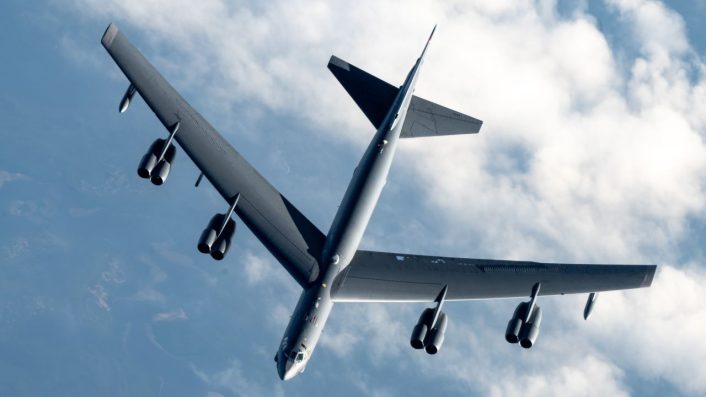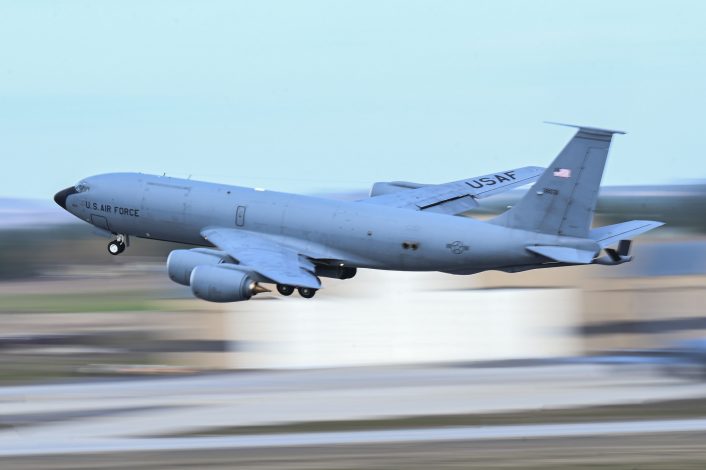92nd and 141st Air Refueling Wings were put to test during a no-notice Nuclear Operational Readiness Inspection whose goal was to assess the readiness of the air refueling wings to support U.S. Stratcom-assigned strategic bomber.
A U.S. Air Force B-52 Stratofortress bomber took part along with KC-135 tankers in a “no-notice” Nuclear Operational Readiness Inspection (NORI) under the aegis of Air Mobility Command (AMC) on July 16 and 18, 2024, over the Pacific Northwest. The goal was to test the 92nd and 141st Air Refueling Wings (ARWs) from Fairchild Air Force Base (AFB) in Washington and their ability to support U.S. Strategic Command (STRATCOM) aircraft with their KC-135 Stratotankers at a moment’s notice.
Photos released by the U.S. Air Force show a B-52 departing the tanker after refueling from a KC-135 on July 18, 2024. “During the NORI, Airmen demonstrated how various capabilities at Fairchild AFB enable units to generate and provide, when directed, specially trained and equipped KC-135 Stratotanker aircrews to conduct critical air refueling of U.S. Strategic Command-assigned strategic bomber and command and control aircraft,” the caption said.
A US Air Force KC-135 Stratotanker refuels a B-52H Stratofortress over Pacific Northwest on July 18.
92nd and 141st Air Refueling Wings were put to test during a no-notice Nuclear Operational Readiness Inspection on July 16–18. pic.twitter.com/WKDhEPrU6A
— Ryan Chan 陳家翹 (@ryankakiuchan) July 31, 2024
‘Rapid, sudden readiness to support, strike’
A release from Fairchild AFB said that during the NORI, “Airmen demonstrated how the base’s units “generate and provide, when directed, KC-135 Stratotanker aircrews” to conduct “critical air refueling” of STRATCOM aircraft.
“In an increasingly complex security environment, the nation expects all components of the nuclear enterprise to comply with unwavering security, safety and reliability standards,” said 92nd ARW’s deputy commander Col. Garret Bilbo.
No-notice inspections validate the need for Airmen at Fairchild AFB to “train” and “remain postured.”
Col. Travis Edwards, the AMC (Air Mobility Command) Inspector General said these inspections help “assess the readiness of our nuclear wings.” Interestingly, the statement went on to mention “Great Power Competition,” reflecting the confrontation with peer rivals Russia and China, motivating the U.S Air Force and Space Force to announce “24 sweeping changes” split amongst four separate categories. These are “Develop People, Generate Readiness, Project Power, Develop Categories.”

Generate Readiness involves “no-notice or limited-notice operational readiness assessments and inspections.” A “no-notice NORI grades a wing’s operational effectiveness and response time” in support of the US STRATCOM. “Fairchild plays a critical role in nuclear readiness and strategic deterrence,” said Edwards.
The statement means that despite being a support wing concerned with aerial refueling, its readiness is also taken into account by potential adversaries in planning their own operations. This is because a poor ability to swiftly send up aerial refueling tankers or a lack of such planes means frontline tactical and strategic aircraft would be constricted in their operations.

These no-notice inspections expose the crews at Fairchild AFB to “real world events.” “We can see how we would respond in a real-world situation. Yes, we are the biggest tanker fleet and yes, we can perform under pressure,” said Master Sgt. Alejandro Vazquez, the production superintendent at the 92nd Aircraft Maintenance squadron.
Their role is to get the “pre-flight team on the aircraft, fueling the jet to the required amount, and ensuring” the presence of “all the necessary equipment onboard” before the aircrew takes over. No-Notice and limited-notice operational readiness drills are a “part of the plans unveiled by senior military and civilian leaders” for reoptimizing forces for Great Power Competition.
This week, the 92nd and 141st Air Refueling Wings completed a no-notice Nuclear Operational Readiness Inspection.
When tested without warning, we can ensure and demonstrate that we are primed for real world nuclear deterrence operations at all times.https://t.co/b2OvI2AoJN pic.twitter.com/Hk9xatyu6V
— Fairchild AFB (@TeamFairchild) July 19, 2024
Non-combat, support and technical elements
Other recent exercises mark how the U.S. has been reorienting itself to conventional wars following unconventional, low-intensity conflicts with non-state actors for nearly two decades. Between Jul. 29 and Jul. 1, 2024, a USAF KC-46 Pegasus aerial refueling aircraft executed the world’s first non-stop westbound circumnavigation endurance flight, called Project Magellan.
The aircraft refueled B-2 Spirit bombers, C-17 Globemaster III airlifters, F-15E Strike Eagles and another KC-46 over the Pacific Ocean, Asia, Europe and the Atlantic Ocean. The flight across all these regions represented a scenario of sudden eruption of conflicts in the flashpoints here, where the U.S. military might have to simultaneously support its own and Allied forces.
Otherwise, drilling logistical, support and techno-logistical elements of tactical and strategic strike operations is a common feature among air forces.
From Jun. 10 to Jun. 13, 2024, Barksdale AFB in Louisiana held Exercise Bayou Warrior, where the 2nd Bomb Wing loaded the AGM-158 JASSM (Joint Air-to-Surface Standoff Missile). This was part of a “readiness exercise.”
Previous exercises involving the B-52s, like Prairie Vigilance in April, saw crews loading the AGM-86B ALCM (Air-Launched Cruise Missile) on B-52H bombers at Minot AFB. In general, these drills underscore the logistical, non-combat and technical support element of warfighting.

